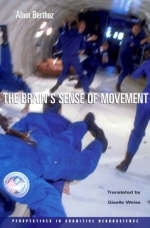
The Brain's Sense of Movement
Seiten
2000
Harvard University Press (Verlag)
978-0-674-80109-7 (ISBN)
Harvard University Press (Verlag)
978-0-674-80109-7 (ISBN)
- Titel ist leider vergriffen;
keine Neuauflage - Artikel merken
This interpretation of perception and action allows Alain Berthoz to focus on psychological phenomena: proprioception and kinaesthesis; the mechanisms that maintain balance and co-ordination actions; and basic perceptual and memory processes involved in navigation.
The neuroscientist Alan Berthoz experimented on Russian astronauts in space to answer these questions: how does weightlessness affect motion? how are motion and three-dimensional space perceived? In this book, the author describes how human beings on earth perceive and control bodily movement. Reviewing a wealth of research in neuro-physiology and experimental psychology, he argues for a rethinking of the traditional separation between action and perception, and for the division of perception into five senses. In Berthoz's view, perception and cognition are inherently predictive, functioning to allow us to anticipate the consequences of current or potential actions. The brain acts like a simulator that is constantly inventing models to project onto the changing world, models that are corrected by steady, minute feedback from the world. We move in the direction we are looking, anticipate the trajectory of a falling ball, recover when we stumble, and continually update our own physical position, all thanks to this sense of movement.
This interpretation of perception and action allows Berthoz, in this work, to focus on psychological phenomena largely ignored in standard texts: proprioception and kinaesthesia, the mechanisms that maintain balance and co-ordinate actions, and basic perceptual and memory processes involved in navigation.
The neuroscientist Alan Berthoz experimented on Russian astronauts in space to answer these questions: how does weightlessness affect motion? how are motion and three-dimensional space perceived? In this book, the author describes how human beings on earth perceive and control bodily movement. Reviewing a wealth of research in neuro-physiology and experimental psychology, he argues for a rethinking of the traditional separation between action and perception, and for the division of perception into five senses. In Berthoz's view, perception and cognition are inherently predictive, functioning to allow us to anticipate the consequences of current or potential actions. The brain acts like a simulator that is constantly inventing models to project onto the changing world, models that are corrected by steady, minute feedback from the world. We move in the direction we are looking, anticipate the trajectory of a falling ball, recover when we stumble, and continually update our own physical position, all thanks to this sense of movement.
This interpretation of perception and action allows Berthoz, in this work, to focus on psychological phenomena largely ignored in standard texts: proprioception and kinaesthesia, the mechanisms that maintain balance and co-ordinate actions, and basic perceptual and memory processes involved in navigation.
| Erscheint lt. Verlag | 14.7.2000 |
|---|---|
| Reihe/Serie | Perspectives in Cognitive Neuroscience |
| Übersetzer | Giselle Weiss |
| Zusatzinfo | 43 line illustrations |
| Verlagsort | Cambridge, Mass |
| Sprache | englisch |
| Maße | 155 x 235 mm |
| Gewicht | 630 g |
| Themenwelt | Geisteswissenschaften ► Psychologie ► Allgemeine Psychologie |
| Geisteswissenschaften ► Psychologie ► Verhaltenstherapie | |
| Medizin / Pharmazie ► Medizinische Fachgebiete ► Neurologie | |
| Naturwissenschaften ► Biologie ► Humanbiologie | |
| Naturwissenschaften ► Biologie ► Zoologie | |
| ISBN-10 | 0-674-80109-1 / 0674801091 |
| ISBN-13 | 978-0-674-80109-7 / 9780674801097 |
| Zustand | Neuware |
| Informationen gemäß Produktsicherheitsverordnung (GPSR) | |
| Haben Sie eine Frage zum Produkt? |
Mehr entdecken
aus dem Bereich
aus dem Bereich
Techniken der Verhaltenstherapie
Buch (2024)
Julius Beltz GmbH & Co. KG (Verlag)
CHF 48,95


